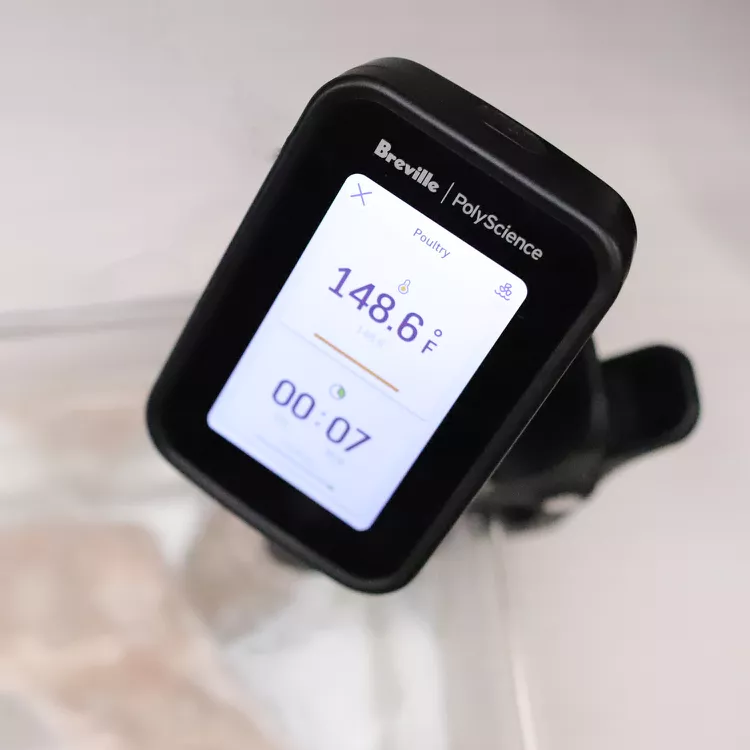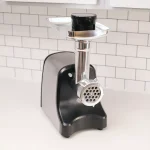- Calculates cook settings
- Easy to raise/lower to fit pots
- Three water speed settings
- Expensive
- Large and heavy
- No recipe app
Breville’s The Hydro Pro Review brings some impressive tools to sous vide cooking and maintains the temperature precisely, making it well worth the high price tag.
Editor’s Note (October 2023): Our review of the Breville HydroPro was first published in 2021. While we continue to review new models and alternatives, we feel that this product continues to meet our rigorous testing standards as one of the best sous vide cookers.
We purchased the Breville The Hydro Pro so our reviewer could put it to the test in her kitchen. Keep reading for our full product review.
Have you ever wondered how restaurants and professional cooks alike always make a perfectly medium-rare steak? Although it’s impossible to know every chef’s secret, a great but sometimes time-consuming way to cook the perfect steak (or other protein) is using sous vide cooking. Sous vide cooking uses precise temperatures and times to cook food evenly. You simply drop a vacuum-sealed bag into a large pot of water and let it work its magic. There are plenty of machines and circulators on the market that helps home cooks achieve such results in their own kitchen. One such machine is Breville’s The Hydro Pro sous vide immersion circulator.
I’ve been cooking using sous vide since I attempted using a cooler, hot water, and a lot of blankets, so I was more than ready to test the high-end Breville The Hydro Pro. I had my bags and vacuum sealer ready. From short cooks to long, and from low temperatures to high, I planned my meals around sous vide to test all of the device’s skills.
:max_bytes(150000):strip_icc():format(webp)/Breville-PolyScience-Sous-Vide-02-53bf6fb3058c43a9a1208e6eaf9b49c2.jpg)
Design: Adjustability
This circulator is larger and heavier than most I’ve used, but not so large that it was difficult to handle. It was, however, too large to fit through the hole in the lid of my favorite sous vide tub. Along with the larger size came a larger screen, which I appreciated because it offered plenty of information, both as I set it up to cook and as it was cooking.
One thing I really loved was the clamp. Instead of having to twist a knob to loosen or tighten the device’s grip on the side of the container, this has a squeeze clamp. It’s a bit stiff, but it holds nice and tight, no matter if the container is round or square. It worked on a lipless pot, a plastic tub with a lip, and a pot with a flared edge.
The other part of the clamp assembly holds onto the circulator, with a latch that releases the grip on the circulator to raise it, lower it, or turn it. I appreciated how easy it was to adjust the position of the circulator when I moved to different containers, raising and lowering it so the minimum and maximum water levels worked best for me. It was also great to be able to turn the circulator so that the screen faced the way I wanted it to.
A padded carrying case is included with this unit. While I am unlikely to be traveling with my sous vide, it’s also a great storage case that will keep it from getting bumped and damaged in the pantry.
Setup Process: Easy cooking, no matter which mode
Setting this up for cooking is simple, and it works much like other circulators when using the manual mode to set a desired time and temperature. I liked that I could tap in the numbers rather than endlessly pressing up and down buttons to change the settings.
This also has what’s called the Sous Vide Toolbox, which calculates the proper time and temperature for a wide variety of foods.
This cooker doesn’t have a companion app, so there was no need to introduce it to my WiFi.
:max_bytes(150000):strip_icc():format(webp)/Breville-PolyScience-Sous-Vide-04-4775abbf2dc74f44ba4a5dc7b80765b2.jpg)
Performance: Slow and steady cooks the food
One important consideration when using sous vide is that the temperature needs to remain stable during the entire cooking time. The Hydro Pro stayed remarkably stable, no matter what temperature I chose. When I made short ribs that required 144 degrees for 72 hours, the temperature never nudged away from the 144 degrees any time I checked it.
In fact, the only time I saw the temperature change during that long cook was when I added more water to make up for evaporation. It displayed a temperature change immediately and then quickly returned to my target temperature.
When I wanted to move my pot to another location during a cook, I unplugged The Hydro Pro, which simulated a power outage. When I plugged it back in, it resumed cooking, and it also left me a message that the circulator had lost power. More important, though: It let me know what temperature the water was when the cooking resumed, and that message stayed on the screen until I acknowledged it.
When I made short ribs that required 144 degrees for 72 hours, the temperature never nudged away from the 144 degrees any time I checked it.
That slight temperature drop wasn’t a critical bit of information when the circulator was off for just a few minutes, but if the power went out overnight, knowing the lowest temperature would be important. If it dropped from 170 to 140 degrees, that wouldn’t be a concern because the lowest temperature was still food-safe. But if the food fell to room temperature, I’d be concerned.
Also important for sous vide cooking is that all the water in the container—and particularly the water surrounding the food—is the same temperature. This immersion circulator takes its circulating job seriously, with three different water speeds. The highest water circulation setting is quite brisk, but even the low speed rippled the top of the water in my container.
During a 72-hour cook of some tough beef, I used the circulator in a stockpot. To thwart evaporation, I tossed sous vide balls into the pot, as I often do. I immediately noticed a disturbing rattling sound and worried that the circulator was somehow malfunctioning. But then I discovered that with the circulation speed on high, the water was moving so much that the plastic balls floating on top of the water were bouncing against the side of the pot, making the rattling sound. That’s some serious water movement.
While I didn’t need the speed that high for that particular cook, it’s good to know that it’s available in case I plan on using a larger container where it’s more difficult to move the water enough to keep the temperature even throughout.
:max_bytes(150000):strip_icc():format(webp)/Breville-PolyScience-Sous-Vide-03-6a914e549d524104b7749826b587c263.jpg)
Features: The toolbox is a winner
The feature I really loved was the sous vide toolbox. This handy program calculates the right cooking times for a wide variety of foods, but it’s not just general times and temperatures. Depending on the chosen food, it asks how thick the food is, whether it’s a tough or tender cut, what shape the food is, whether it’s fresh or frozen, and what doneness is preferred.
But that’s not all. It also asked if I wanted to cook it just until the core reached the target temperature, whether it should continue cooking to pasteurize the outside, or whether it should keep going until the food is pasteurized all the way to the core. When cooking solid foods like a pork chop or a steak, pasteurizing the outside is likely all that’s needed—or perhaps not needed at all if the food will be seared. But for cooking something like a rare burger, the ability to pasteurize it all the way through can make a difference in the safety of the end product.
The highest water circulation setting is quite brisk, but even the low speed rippled the top of the water in my container.
I was impressed at the number of choices for cooking simple eggs, from pasteurization without cooking (which is great for making recipes using uncooked eggs, like Caesar salad, mayonnaise, or cocktails), all the way to making hard-boiled eggs.
When I decided to make egg bites in a jar, the force of the water circulation at medium speed was enough to scoot my half-pint jars across the bottom of my container. On low, the jars stayed in place but still wobbled a bit. If someone is cooking eggs in the shell, letting them float free in a pot would likely cause some breakage, so I suggest using something to contain the eggs as they cook.
For butter-basted potatoes, I used my own recipe, which was simple to set using the manual controls. Next, I let the circulator calculate my cooking time for steak. With the precise temperature control, of course, my food cooked exactly the way I wanted.
:max_bytes(150000):strip_icc():format(webp)/Breville-PolyScience-Sous-Vide-05-418b7fcac9a54175813fd0f01b6d23c6.jpg)
I found a recipe for sous vide bacon, where it takes a long bath in 150-degree water before more traditional frying, and again the temperature remained steady for the three-hour cook. My sous vide eggs bites in mason jars were the perfect accompaniment for the bacon.
Besides meats, vegetables, and eggs, this also has settings for set or liquid custards as well as yogurt, so there’s not much need to look up cooking times and temperatures for most common foods.
What this doesn’t have is recipes, since there’s no app. That makes sense because this is aimed at professional cooks who wouldn’t need step-by-step recipes. Fortunately, sous vide cooking has been around long enough that there are plenty of recipes online as well as in sous vide cookbooks.
While I used the toolbox for some of my cooks, I also have recipes I’ve made multiple times that are exactly the way I like them. Of course, I could enter them manually each time, but this has the ability to save favorites for future use. I added my own settings for 72-hour short ribs, and I’ll be adding more recipes as I make them so that I won’t need to look them up again.
The notification beep is worth noting since it’s quite shrill. It was easy to hear at a distance, and it wasn’t the same beep as any of my other devices, so I recognized it. The volume can be turned up or down, as can the brightness on the screen.
This circulator touts its ease of cleaning, and I agree. It’s simple to disassemble for hand-cleaning, and when deep cleaning is required, there’s information on descaling with vinegar and water. There’s also information on how to change the direction of the water flow—it’s as simple as twisting the bottom, but it’s nice to have the reminder.
:max_bytes(150000):strip_icc():format(webp)/Breville-PolyScience-Sous-Vide-06-e3f83331717e4c9a9872a96a634e6c0f.jpg)
Price: Expensive
The Hyrdo Pro retails for around $500. There’s no doubt about it: This is an expensive piece of equipment. But that’s no surprise since it’s marketed for professionals and for serious home cooks who want the best cooking technology at their fingertips. This is a well-made, sturdy device that I expect will last a long time, so I think it’s worth it for serious cooks who want extreme precision.
Breville’s The Hydro Pro vs. Anova Precision Cooker
Anova Precision Cooker: Anova has made a name for itself with sous vide devices, and the Anova Precision Cooker is quite popular—and the price is much lower than the Hydro Pro (it retails for around $199). I’d recommend the Anova for cooks who are looking for a less expensive product that’s still good quality and that does its job well. But I’d certainly nudge serious cooks to buy The Hydro Pro if it can squeeze into their budget. It’s fun to use, and the steady, precise temperature control is quite impressive.
If you can afford it, you’ll love it.
I quickly fell in love with the sous vide toolbox on Breville’s The Hydro Pro when I used it to cook my first steak. There was no guessing on my part when choosing the right cooking time, and no need to look up the temperature. From the super-precise temperature control to the ability to save your favorite recipes, I believe this machine is a must-have if you can afford it.
Specs
- Product NameThe Hydro Pro
- Product BrandBreville|PolyScience
- Price$500.00
- Weight4.2 lbs.
- Product Dimensions3.7 x 14.6 in.
- MaterialStainless steel and plastic
- Warranty1 year
- What’s IncludedComes with a padded case



